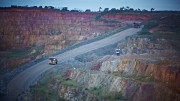With respect to Lesley Stokes’ feature article, “Mining the unexpected: When ‘poor geology’ becomes a problem” (T.N.M., Jan. 4–10, 2016), the rash of recent failures is not derived from a lack of information — it is the failure to capture and incorporate the available geological information into the resource model. This applies equally to the issuer and resource consultants.
All too often, and SRK was a leader in this approach, the resource model is constrained by a grade shell (e.g., Leapfrog shells imported into GEMs or other software, and used as the controlling domains). This has become the standard approach whereby geological controls have effectively been removed from the resource modelling process. A resource model must be built from a geological model, not an assay cloud!
The original rationale behind the grade domains was simple: it was much quicker and simpler, no interpretation was required and as a consultant, you don’t need the expensive and time-consuming review of the geology of the deposit. And in many instances dealing with issuers, the geological information was not collected or captured, or was in such a state of disrepair as to be unreliable.
It was a practical shortcut that became the standard operating procedure and unravelled into the dark chasm of “implicit modeling.” Yes, not only can software create grade models (e.g., interpolated blocks of ore grade), but now it can create geological models. The end is nigh!
The false sense of security that some derive from additional modelling algorithms is also a clear alarm for anyone reviewing resource models (e.g., Kriging is better than inverse distance … no, multiple indicator kriging is better than ordinary kriging … no, uniform conditioning is required on this special deposit!)
If the “mineability” of your deposit depends on some special solution or the gridding algorithm, then you have another fatal flaw in the process.
Other key flaws occur in the parameters chosen, such as capping, compositing, block size, search ellipse, etc. These factors are necessarily limited by the geological controls (i.e., the 3-D structural, stratigraphic, alteration, geotechnical, metal distribution, etc.), not mining controls or arbitrary “expert opinions.”
Once again, there is no shortage of information and virtually all technical reports demonstrate the available data. However, in an amazing number of cases, the data is subjugated based on variograms and mining plans. For example, the 2,500-tonne-per-day long-hole because it is cheaper and looks better in a preliminary economic analysis, regardless if the deposit can handle it via mining loss and dilution.
The “special case” of narrow vein deposits is yet another common fallacy necessitated due to the lack of structural controls incorporated into the resource (i.e., block) model. An example is a series of en echelon tension gash high-grade veins within some “panel” (ah, the famous “shear zone”). These dots of high-grade assays connect in a line, and without field observations (i.e., a series of isolated sub-metre veins at some other orientation), the variography and grade shells create a completely false domain that, when mined, will never meet expectations with regards to head grade and dilution costs, etc.
Capturing this information and incorporating it into a proper geological model will help manage expectations. That is to say, given this real scenario, what is the appropriate mining method, and with the concomitant financial implications, do we still want to make this investment?
Most deposits won’t pass this test, and that is a good thing for our industry.
Geology has been largely removed from the modelling process and the good and great geologists are giving up on modelling, due to the lack of input and consistent failure to meet expectations.
This is an understated and alarming development!
Instead of recognizing the problem and bringing more geological information and skill into the process, the industry has devolved and now points the finger at exogenous factors — yes, every model would be perfect at 1-metre drill centres.
But that won’t happen. Not just because it is cost prohibitive, but because it is not needed to build a reliable model in most cases.
Improve quality control on all data inputs. Start with a well-built geological model that captures all available data in a robust scenario, prioritize geological controls in the resource modelling process and then build a mine plan around what the geology can actually provide.
As Mick Jagger sings: “If you try sometimes, you just might find, you get what you need!”
Mark
via the Internet



Dear Mark/Mick: Your column is a breath of fresh air. Many thanks for clearly explaining an issue which is often ignored, and poorly understood. Fast, Cheap, Good. Pick any two. Quoting Jack Johnson, “Maybe pretty much always means no” Regards
Mark,
Indeed, several people have voiced this concern in the last few years, pretty much along the same lines but you’ve done a good job at summarising and wording it I must say.
Models are there to reflect the mineralisation as it occurs in the deposit. I don’t mind implicit modelling at all and it is a great tool in my view, but I agree that it gets abused frequently.
The one line that is most important in your piece is “Improve quality control on all data inputs.” The problem is that you cannot build those sound geological models if you have 20 different geologists logging something very intricate. Resource geologists are under pressure to deliver and once they get the “validated” data (yeah right) there is no scope/time to really improve the geological model, as much as sometimes they might like. Client’s expectations and changing standards…..
One client allowed me to do this work properly and i turned it into a case study. I find the results underlining your point: 12 holes drilled in the wrong direction and none of the several consultants over the last 15 years had picked up on it, probably because they weren’t given the time to do so. Pretty hard modelling geology in that case (download Konongo paper available from rscmme website).
Get your data input right….. that’s where it starts. What modelling technique you use is utterly trivial at that stage.
This should be required reading for all “resource geologists.” I’m trying to get some young people training in traditional wireframing, and the software consultant went right to their standby implicit modeler. It Took some time to communicate what I was really looking for. It’s as if we live in a world where there is no such thing as a fault. What is concerning for me is that the largest software providers are overwhelmingly stocked with very young geologists or mining engineers just out of school. These young geologists and engineers are immediately inducted into implicit modeling, then become instructors for the wider industry. That you never learned the time intensive, step-by-step approach to geological modeling. I remember when I first saw go CAD, and I thought “this is a useful tool for a quick and dirty first look at geochemical shells,” but it should never replace robust three-dimensional thinking.